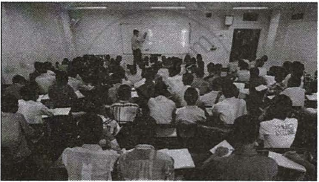Advertisements
Advertisements
प्रश्न
Find the value of k for which the system of linear equations has an infinite number of solutions:
2x + (k – 2)y = k,
6x + (2k - 1)y = (2k + 5).
उत्तर
The given system of equations:
2x + (k – 2)y = k
⇒ 2x + (k – 2)y - k = 0 ….(i)
And, 6x + (2k - 1) y = (2k + 5)
⇒ 6x + (2k - 1) y - (2k + 5) = 0 …(ii)
These equations are of the following form:
`a_1x+b_1y+c_1 = 0, a_2x+b_2y+c_2 = 0`
where, `a_1 = 2, b_1= (k – 2), c_1= -k and a_2 = 6, b_2 = (2k - 1), c_2= -(2k + 5)`
For an infinite number of solutions, we must have:
`(a_1)/(a_2) = (b_1)/(b_2) = (c_1)/(c_2)`
`2/6 = ((k−2))/((2k−1)) =( −k)/(−(2k+5))`
`⇒1/3 = ((k−2))/((2k−1)) = k/((2k+5))`
Now, we have the following three cases:
Case I:
`1/3 = ((k−2))/((2k−1))`
⇒ (2k – 1) = 3(k – 2)
⇒ 2k - 1 = 3k – 6 ⇒ k = 5
Case II:
`((k−2))/((2k−1)) = k/((2k+5))`
⇒ (k - 2) (2k + 5) = k(2k - 1)
`⇒ 2k^2 + 5k – 4k – 10 = 2k^2 – k`
⇒ k + k = 10 ⇒ 2k = 10 ⇒ k = 5
Case III:
`1/3 = k/((2k+5))`
⇒ 2k + 5 = 3k ⇒ k = 5
Hence, the given system of equations has an infinite number of solutions when k is equal to 5.
APPEARS IN
संबंधित प्रश्न
The cost of 2 kg of apples and 1 kg of grapes on a day was found to be Rs 160. After a month, the cost of 4 kg of apples and 2 kg of grapes is Rs 300. Represent the situation algebraically and geometrically.
Speed of a boat in still water is 15 km/h. It goes 30 km upstream and returns back at the same point in 4 hours 30 minutes. Find the speed of the stream.
For what value of , the following system of equations will be inconsistent?
4x + 6y - 11 = 0
2x + ky - 7 = 0
Solve for x and y:
`5/(x+y) - 2/(x−y) = -1, 15/(x+y) - 7/(x−y) = 10`
Find the value of k for which the system of linear equations has a unique solution:
(k – 3) x + 3y – k, kx + ky - 12 = 0.
Find the value of k for which the system of equations
8x + 5y = 9, kx + 10y = 15
has a non-zero solution.
A man invested an amount at 10% per annum simple interest and another amount at 10% per annum simple interest. He received an annual interest of Rs. 1350. But, if he had interchanged the amounts invested, he would have received Rs. 45 less. What amounts did he invest at different rates?
A man has some hens and cows. If the number of heads be 48 and number of feet by 140. How many cows are there.
Show that the system 2x + 3y -1= 0 and 4x + 6y - 4 = 0 has no solution.
Read the following passage:
|
A coaching institute of Mathematics conducts classes in two batches I and II and fees for rich and poor children are different. In batch I, there are 20 poor and 5 rich children, whereas in batch II, there are 5 poor and 25 rich children. The total monthly collection of fees from batch I is ₹9,000 and from batch II is ₹26,000. Assume that each poor child pays ₹x per month and each rich child pays ₹y per month.
|
Based on the above information, answer the following questions:
- Represent the information given above in terms of x and y.
- Find the monthly fee paid by a poor child.
OR
Find the difference in the monthly fee paid by a poor child and a rich child. - If there are 10 poor and 20 rich children in batch II, what is the total monthly collection of fees from batch II?

